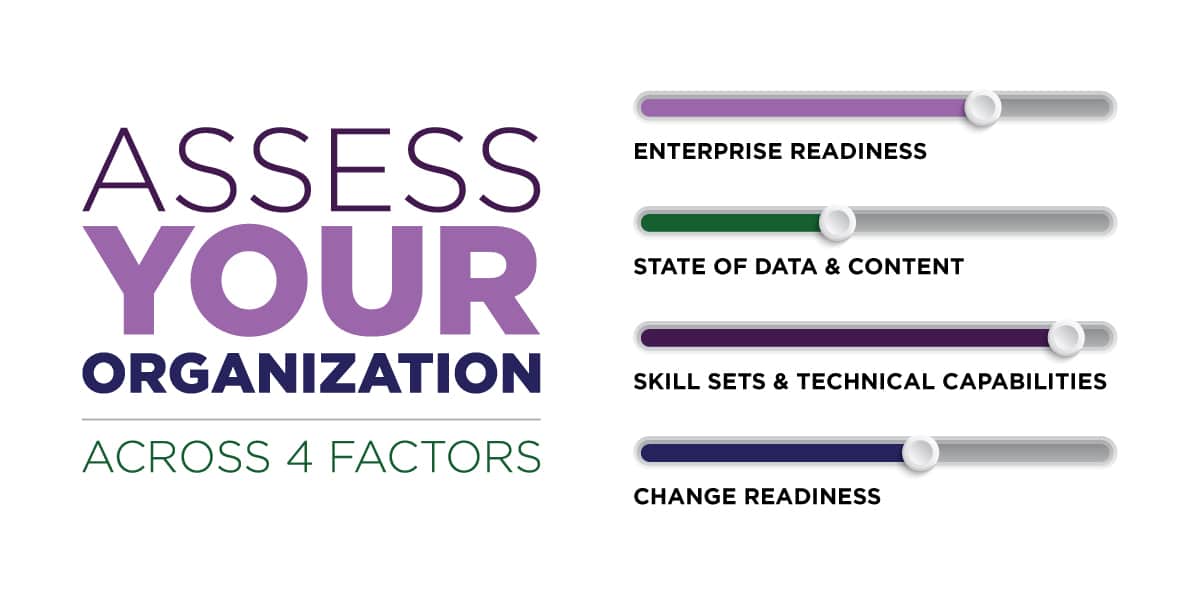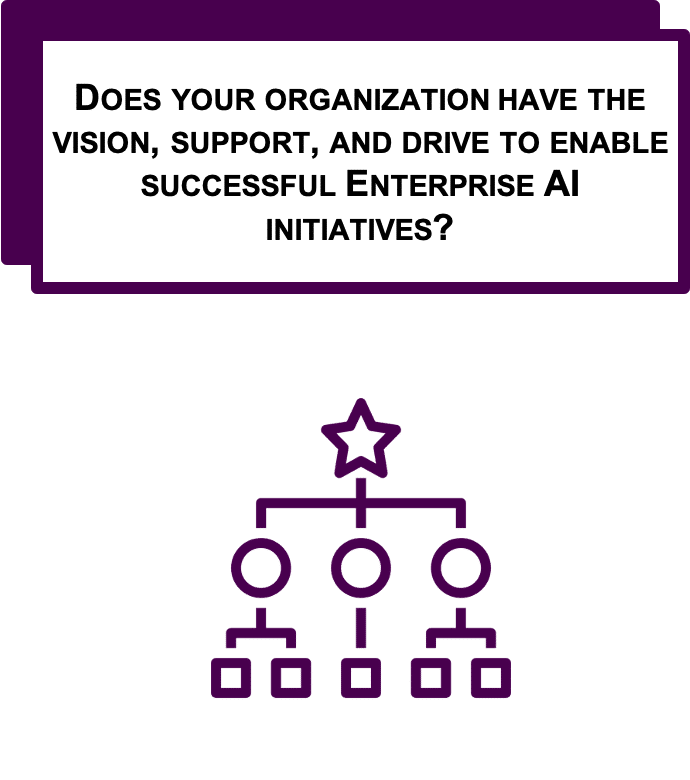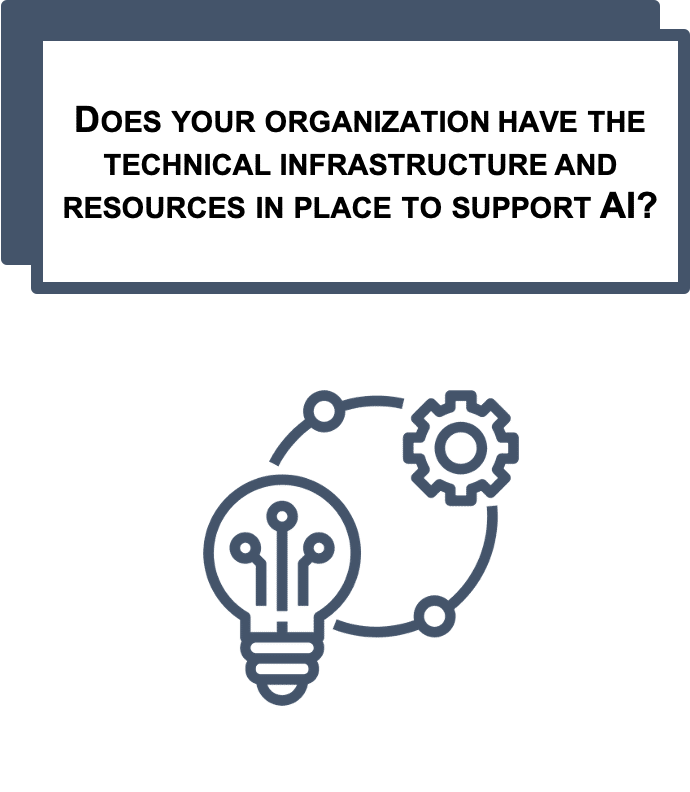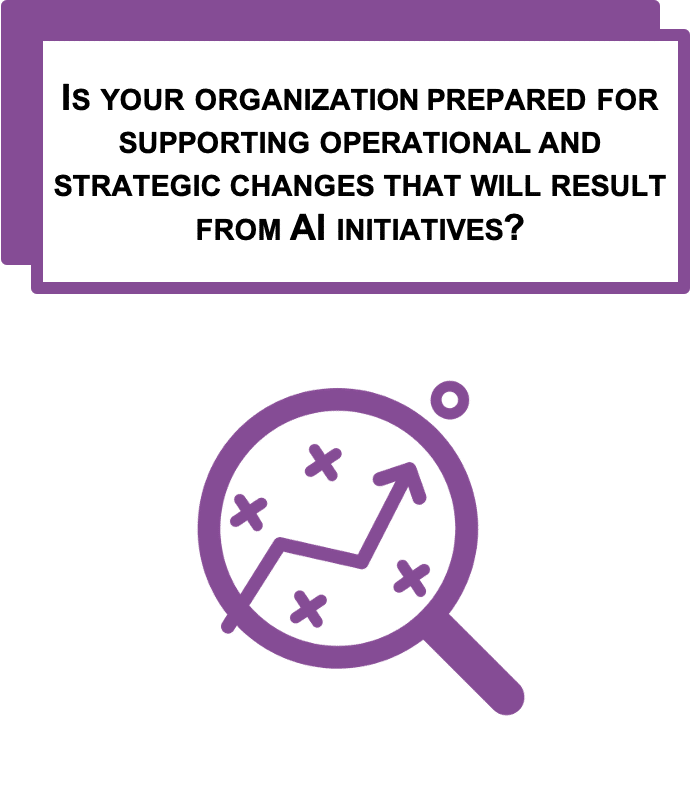A wide range of organizations have placed AI on their strategic roadmap, with C-levels commonly listing Knowledge AI amongst their biggest priorities. Yet, many are already encountering challenges as a vast majority of AI initiatives are failing to show results, meet expectations, and provide real business value. For these organizations, the setbacks typically originate from the lack of foundation on which to build AI capabilities. Enterprise AI projects too often end up as isolated endeavors, lacking the necessary foundations to support business practices and operations across the organization. So, how can your organization avoid these pitfalls? There are three key questions to ask when developing an Enterprise AI strategy; do you have clear business applications, do you understand the state of our information, and what in house capabilities do you possess?
With our focus and expertise in knowledge, data, and information management, Enterprise Knowledge (EK) developed this proprietary Enterprise Artificial Intelligence (AI) Readiness Assessment in order to enable organizations to understand where they are and where they need to be in order to begin leveraging today’s technologies and AI capabilities for knowledge and data management.
 Based on our experience conducting strategic assessments as well as designing and implementing Enterprise AI solutions, we have identified four key factors as the most common indicators and foundations for many organizations in order to evaluate their current capabilities and understand what it takes to invest in advanced capabilities.
Based on our experience conducting strategic assessments as well as designing and implementing Enterprise AI solutions, we have identified four key factors as the most common indicators and foundations for many organizations in order to evaluate their current capabilities and understand what it takes to invest in advanced capabilities.
This assessment leverages over thirty measurements across these four Enterprise AI Maturity factors as categorized under the following aspects.
1. Organizational Readiness
 The foundational requirement for any organization to undergo an Enterprise AI transformation stems from alignment on vision and the business applications and justifications for launching successful initiatives. The Organizational Readiness Factor includes the assessment of appropriate organizational designs, leadership willingness, and mandates that are necessary for success. This factor evaluates topics including:
The foundational requirement for any organization to undergo an Enterprise AI transformation stems from alignment on vision and the business applications and justifications for launching successful initiatives. The Organizational Readiness Factor includes the assessment of appropriate organizational designs, leadership willingness, and mandates that are necessary for success. This factor evaluates topics including:
- The need for vision and strategy for AI and its clear application across the organization.
- If AI is a strategic priority with leadership support.
- If the scope of AI is clearly defined with measurable success criteria.
- If there is a sense of urgency to implement AI.
With a clear picture of what your organizational needs are, your Organizational Readiness assessment factor will allow you to determine if your organization meets the requirements to consider AI related initiatives while surfacing and preparing you for potential risks to better mitigate failure.
2. The State of Organizational Data and Content
 The volume and dynamism of data and content (structured and/or unstructured) is growing exponentially, and organizations need to be able to securely manage and integrate that information. Enterprise AI requires quality of, and access to, this information. This assessment factor focuses on the extent to which existing structured and unstructured data is in a machine consumable format and the level to which it supports business operations within the enterprise. This factor consider topics including:
The volume and dynamism of data and content (structured and/or unstructured) is growing exponentially, and organizations need to be able to securely manage and integrate that information. Enterprise AI requires quality of, and access to, this information. This assessment factor focuses on the extent to which existing structured and unstructured data is in a machine consumable format and the level to which it supports business operations within the enterprise. This factor consider topics including:
- The extent to which the organization’s information ecosystems allow for quick access to data from multiple sources.
- The scope of organizational content that is structured and in a machine-readable format.
- The state of standardized organization of content/data such as business taxonomy and metadata schemes and if it is accurately applied to content.
- The existence of metadata for unstructured content.
- Access considerations including compliance or technical barriers.
AI needs to learn the human way of thinking and how an organization operates in order to provide the right solutions. Understanding the full state of your current data and content will enable you to focus on the right content/data with the highest business impact and help you develop a strategy to get your data in an organized and accessible format. Without high quality, well organized and tagged data, AI applications will not deliver high-value results for your organization.
3. Skills Sets and Technical Capabilities
 With the increased focus on AI, the demand for individuals who have the technical skills to engineer advanced machine learning and intelligent solutions, as well as business knowledge experts who can transform data to a paradigm that aligns with how users and customers communicate knowledge, have both increased. Further, over the years, cloud computing capabilities, web standards, open source training models, and linked open data for a number of industries have emerged to help organizations craft customized Enterprise AI solutions for their business. This means an organization that is looking to start leveraging AI for their business no longer has to start from scratch. This assessment factor evaluates the organization’s existing capabilities to design, management, operate, and maintain an Enterprise AI Solution. Some of the factors we consider include:
With the increased focus on AI, the demand for individuals who have the technical skills to engineer advanced machine learning and intelligent solutions, as well as business knowledge experts who can transform data to a paradigm that aligns with how users and customers communicate knowledge, have both increased. Further, over the years, cloud computing capabilities, web standards, open source training models, and linked open data for a number of industries have emerged to help organizations craft customized Enterprise AI solutions for their business. This means an organization that is looking to start leveraging AI for their business no longer has to start from scratch. This assessment factor evaluates the organization’s existing capabilities to design, management, operate, and maintain an Enterprise AI Solution. Some of the factors we consider include:
- The state of existing enterprise ontology solutions and enterprise knowledge graph capabilities that optimize information aggregation and governance.
- The existence of auto-classification and automation tools within the organization.
- Whether roles and skill sets for advanced data modeling or knowledge engineering are present within the organization.
- The availability and capacity to commit business and technical SMEs for AI efforts.
Understanding the current gaps and weaknesses in existing capabilities and defining your targets are crucial elements to developing a practical AI Roadmap. This factor also plays a foundational role in giving your organization the key considerations to ensure AI efforts kick off on the right track, such as leveraging web standards that enable interoperability, and starting with available existing/open-source semantic models and ecosystems to avoid short-term delays while establishing long-term governance and strategy.
4. Change Threshold
 The success of Enterprise AI relies heavily on the adoption of new technologies and ways of doing business. Organizations who fail to succeed with AI often struggle to understand the full scope of the change that AI will bring to their business and organizational norms. This usually manifests itself in the form of fear (either of change in job roles or creating wrong or unethical AI results that expose the organization to higher risks). Most organizations also struggle with the understanding that AI requires a few iterations to get it “right”. As such, this assessment factor focuses on the organization’s appetite, willingness, and threshold to understand and tackle the cultural, technical, and business challenges in order to achieve the full benefits of AI. This factor evaluates topics including:
The success of Enterprise AI relies heavily on the adoption of new technologies and ways of doing business. Organizations who fail to succeed with AI often struggle to understand the full scope of the change that AI will bring to their business and organizational norms. This usually manifests itself in the form of fear (either of change in job roles or creating wrong or unethical AI results that expose the organization to higher risks). Most organizations also struggle with the understanding that AI requires a few iterations to get it “right”. As such, this assessment factor focuses on the organization’s appetite, willingness, and threshold to understand and tackle the cultural, technical, and business challenges in order to achieve the full benefits of AI. This factor evaluates topics including:
- Business and IT interest and desire for AI.
- Existence of resource planning for the individuals whose roles will be impacted.
- Education and clear communication to facilitate adoption.
The success of any technical solution is highly dependent on the human and culture factor in an organization and each organization has a threshold for dealing with change. Understanding and planning for this factor will enable your organization to integrate change management that addresses the negative implications, avoids unnecessary resistance or weak AI results, and provides the proper navigation through issues that arise.
How it Works
This Enterprise AI readiness assessment and benchmarking leverages the four factors that have over 30 different points upon which each organization can be evaluated and scored. We apply this proprietary maturity model to help assess your Enterprise AI readiness and clearly define success criteria for your target AI initiatives. Our steps include:
- Knowledge Gathering and Current State Assessment: We leverage a hybrid model that includes interviews and focus groups, supported by content/data and technology analysis to understand where you are and where you need to be.This gives us a complete understanding of your current strengths and weaknesses across the four factors, allowing us to provide the right recommendations and guidance to drive success, business value, and long-term adoption.
- Strategy Development and Roadmapping: Building on the established focus on the assessment factors, we work with you to develop a strategy and roadmap that outlines the necessary work streams and activities needed to achieve your AI goals. It combines our understanding of your organization with proven best practices and methodologies into an iterative work plan that ensures you can achieve the target state while quickly and consistently showing interim business value.
- Business Case Development and Alignment Support: we further compile our assessment of potential project ROI based on increased revenues, cost avoidance, risk and compliance management. We then balance those against the perceived business needs and wants by determining the areas that would have the biggest business impact with lowest costs. We further focus our discussions and explorations on these areas with the greatest need and higher interest.
Keys to Our Assessment
Over the past several years, we have worked with diverse organizations to enable them to strategize, design, pilot, and implement scaled Enterprise AI solutions. What makes our priority assessment unique is that it is developed based on years of real-world experience supporting organizations in their knowledge and data management. As such, our assessment offers the following key differentiators and values for the enterprise:
- Recognition of Unique Organizational Factors: This assessment recognizes that no Enterprise AI initiative is exactly the same. It is designed in such a way that it recognizes the unique aspects of every organization, including priorities and challenges to then help develop a tailored strategy to address those unique needs.
- Emphasis on Business Outcomes: Successful AI efforts result in tangible business applications and outcomes. Every assessment factor is tied to specific business outcomes with corresponding steps on how the organization can use it to better achieve practical business impact.
- A Tangible Communication and Education Tool: Because this assessment provides measurable scores and over 30 tangible criteria for assessment and success factors, it serves as an effective tool to allow your organization to communicate up to leadership and quickly garner leadership buy-in, helping organizations understand the cost and the tangible value for AI efforts.
Results
As a result of this effort, you will have a complete view of your AI readiness, gaps and required ecosystem and an accompanying understanding of the potential business value that could be realized once the target state is achieved. Taken as a whole, the assessment allows an organization to:
- Understand strengths and weaknesses, and overall readiness to move forward with Enterprise AI compared to other organizations and the industry as a whole;
- Judge where foundational gaps may exist in the organization in order to improve Enterprise AI readiness and likelihood of success; and
- Identify and prioritize next steps in order to make immediate progress based on the organization’s current state and defined goals for AI and Machine Learning.
| Get Started | Download Trends | Ask a Question |

